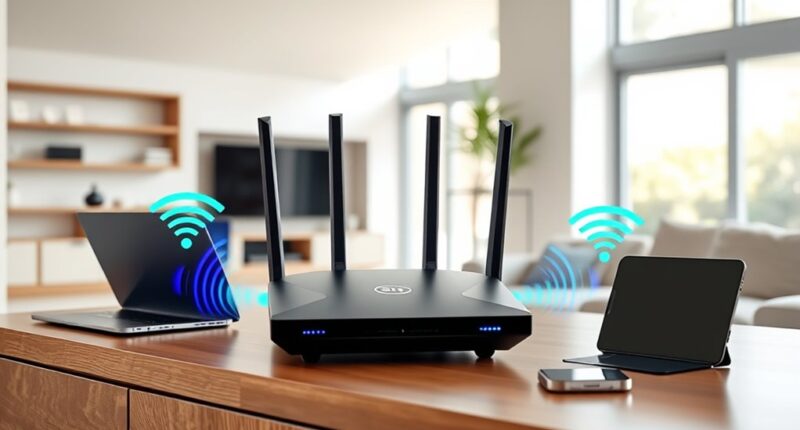Looking for the best Wi-Fi 6 routers of 2025 to boost speed and smart connectivity? I recommend models like the TP-Link Archer AX21, NETGEAR RAX54S, and AXE5400 for their fast speeds, wide coverage, and advanced security features. Whether you need a reliable mesh system or a high-performance gaming router, these choices offer future-proof tech and easy setup. Keep exploring to discover more options that suit your home or office needs.
Key Takeaways
- Top models offer Wi-Fi 6 and Wi-Fi 6E for ultra-fast, low-latency connections suitable for demanding smart homes and gaming.
- Advanced security features like WPA3, NETGEAR Armor, and TP-Link HomeShield ensure safe and protected internet usage.
- Mesh-capable routers with seamless coverage and Ethernet backhaul support eliminate dead zones in large or multi-story homes.
- High processing power, multi-gig ports, and OFDMA technology future-proof the network for increasing device demands.
- User-friendly setup and management apps make it easy to optimize and control your smarter, faster home Wi-Fi network.
TP-Link AX1800 WiFi 6 Router V4 (Archer AX21)
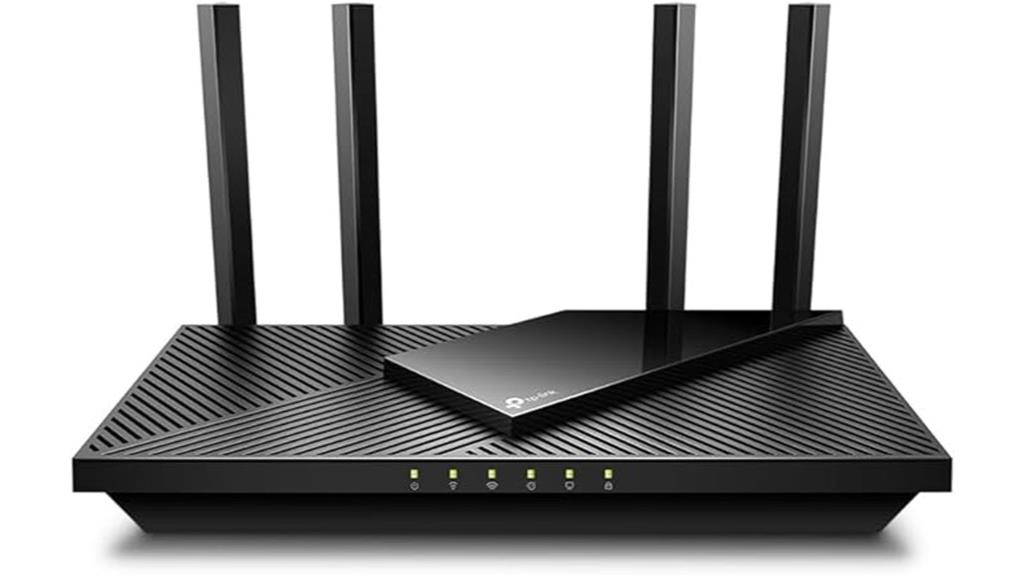
If you’re looking for a reliable and future-proof router, the TP-Link AX1800 WiFi 6 Router V4 (Archer AX21) is an excellent choice. It offers dual-band Wi-Fi 6 with a combined speed of up to 1.8 Gbps, supporting multiple devices seamlessly. Its Beamforming technology and four high-gain antennas guarantee strong, reliable coverage across large areas. Compatible with all major ISPs, it also features Easy Mesh support and Alexa integration for smart home control. Plus, its robust security, easy setup, and dedicated support make it a smart investment for anyone wanting faster, more stable internet in 2025.
Best For: those seeking a reliable, high-speed Wi-Fi 6 router with extensive coverage and smart home integration for large households or tech-savvy users in 2025.
Pros:
- Supports dual-band Wi-Fi 6 with up to 1.8 Gbps combined speeds for seamless multi-device connectivity
- Features Beamforming technology and four high-gain antennas for strong, reliable coverage over large areas
- Compatible with all major ISPs and supports Easy Mesh and Alexa integration for flexible smart home setup
Cons:
- Does not support the 6 GHz band, limiting future Wi-Fi 6E compatibility
- Performance may vary depending on device placement and obstacles like walls
- Requires firmware updates via the Tether app for optimal security and performance
NETGEAR Nighthawk WiFi 6 Router (RAX54S)
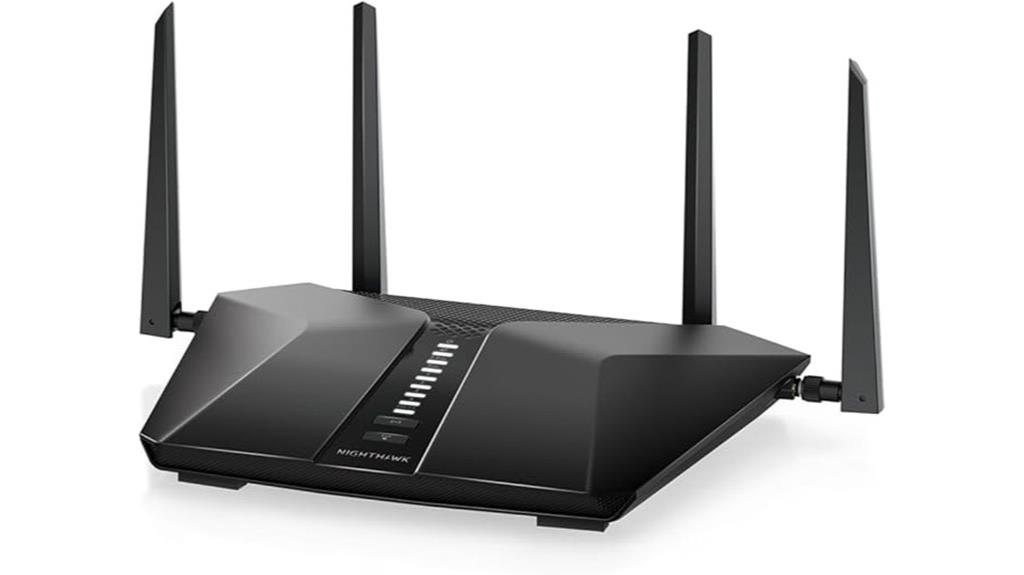
The NETGEAR Nighthawk WiFi 6 Router (RAX54S) stands out as an excellent choice for households that need fast, reliable internet across multiple devices. It delivers AX5400 Gigabit speeds, supporting WiFi 6 for seamless streaming, gaming, and video calls. Covering up to 2,500 sq. ft. and supporting 25 devices, it easily replaces your existing modem-router setup. Equipped with a powerful 1.5GHz triple-core processor and advanced features like OFDMA and 160MHz channels, it maximizes network efficiency. Security is first-rate with NETGEAR Armor, and management is simple via the Nighthawk app. Its sleek design and extended coverage make it a versatile choice for busy homes.
Best For: households needing fast, reliable WiFi coverage for multiple devices, including streaming, gaming, and video conferencing.
Pros:
- Supports AX5400 Gigabit speeds with WiFi 6 technology for seamless performance
- Covers up to 2,500 sq. ft. and supports 25 devices, ideal for larger homes
- Equipped with advanced security features like NETGEAR Armor and parental controls
Cons:
- May be more expensive than basic routers for users with simpler needs
- Primarily designed for use in the U.S., which could limit international compatibility
- Setup and management require using the Nighthawk app, which may be inconvenient for some users
TP-Link AX3000 Wi-Fi 6 Router Archer AX55
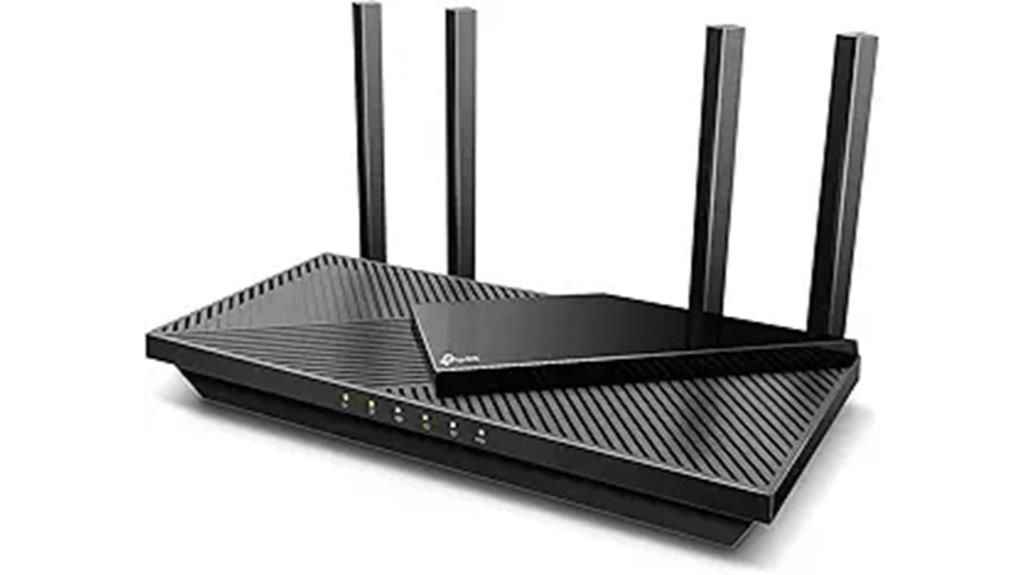
For those seeking reliable, high-speed Wi-Fi coverage across their entire home, the TP-Link AX3000 Wi-Fi 6 Router Archer AX55 stands out with its advanced technology and expansive range. It delivers next-generation Gigabit speeds—2402 Mbps on 5 GHz and 574 Mbps on 2.4 GHz—supporting OFDMA, MU-MIMO, and Beamforming for efficient, strong connections. With four high-gain antennas, it provides broad coverage, reducing dead zones. Plus, its easyMesh compatibility allows seamless integration with other mesh devices. Enhanced security features like TP-Link HomeShield, along with a USB 3.0 port and improved cooling, make this router a smart choice for fast, stable, and secure home Wi-Fi.
Best For: households or small offices seeking reliable, high-speed Wi-Fi coverage with advanced security features and seamless mesh integration.
Pros:
- Supports next-generation Wi-Fi 6 speeds for fast streaming, gaming, and downloads
- Expanded coverage with four high-gain antennas and Beamforming technology
- EasyMesh compatibility and TP-Link HomeShield security for enhanced network management and safety
Cons:
- May be more expensive than basic routers without mesh or Wi-Fi 6 capabilities
- Setup and configuration can be complex for non-technical users
- Limited to home and small office environments, not ideal for very large or enterprise networks
TP-Link AXE5400 WiFi 6E Router
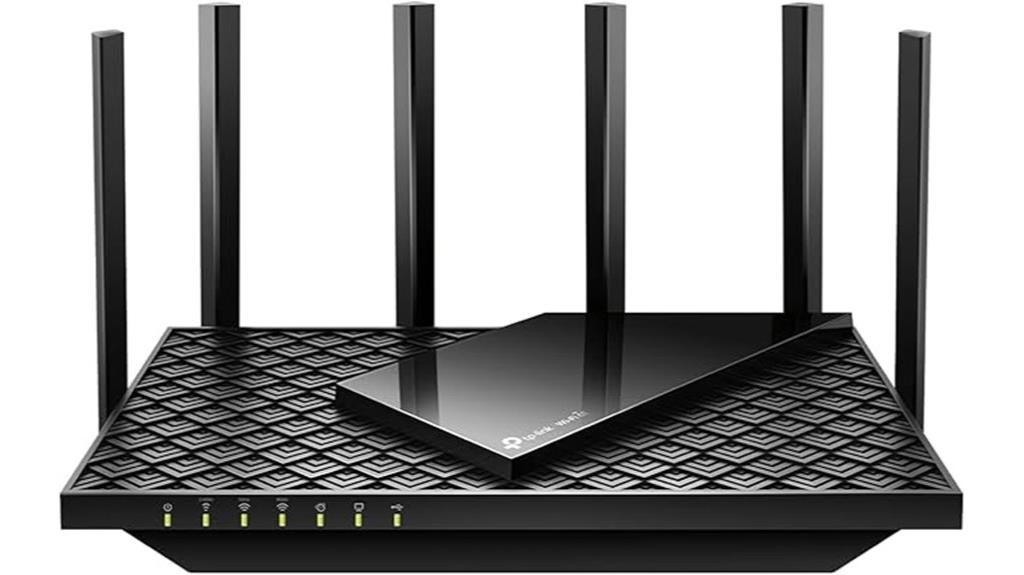
Power users and gamers seeking lightning-fast, low-latency connections will find the TP-Link AXE5400 WiFi 6E Router to be an ideal choice, thanks to its tri-band setup and support for WiFi 6E’s new 6 GHz band. It offers combined speeds up to 5400 Mbps, with dedicated 6 GHz, 5 GHz, and 2.4 GHz bands for maximum performance. Equipped with a powerful 1.7 GHz quad-core CPU and 512 MB RAM, it handles multiple devices seamlessly. Plus, features like OFDMA, OneMesh, TP-Link HomeShield security, and VPN support make it a versatile, future-proof choice for high-demand homes and gaming setups.
Best For: power users and gamers seeking ultra-fast, low-latency internet with seamless device connectivity in a high-demand home environment.
Pros:
- Supports WiFi 6E with a dedicated 6 GHz band for faster speeds and reduced interference
- Tri-band setup (6 GHz, 5 GHz, 2.4 GHz) for optimal network performance and device management
- Equipped with a powerful 1.7 GHz quad-core CPU and 512 MB RAM for smooth multi-device handling
Cons:
- Requires a compatible modem for most ISPs, adding to setup complexity
- Larger size may be less suitable for small spaces or cluttered areas
- Premium features like TP-Link HomeShield may require additional subscription for full access
NETGEAR WiFi 6 Router (R6700AXv3)
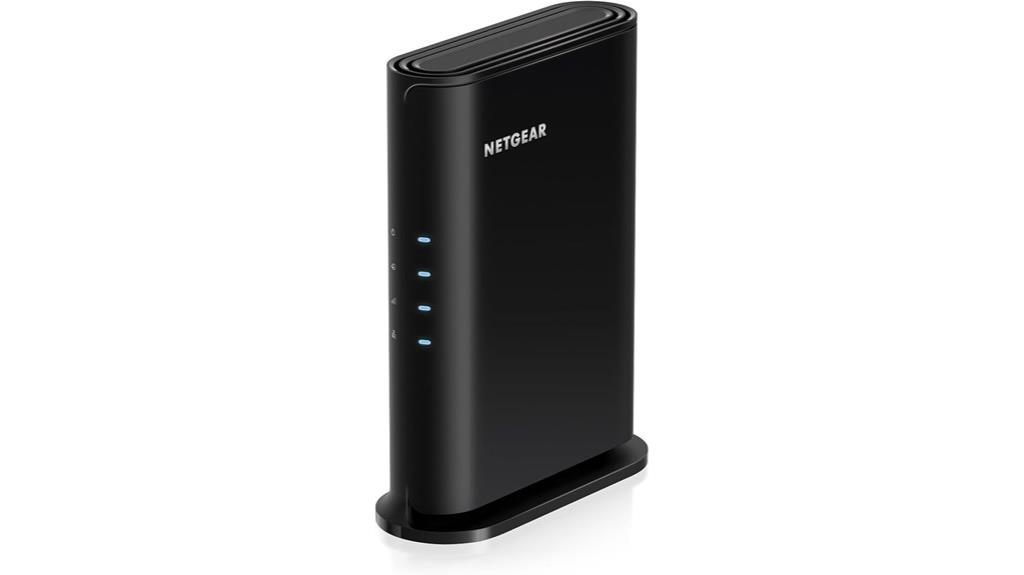
If you’re looking to upgrade your home or small office network with reliable speed and coverage, the NETGEAR WiFi 6 Router (R6700AXv3) is an excellent choice. It offers AX1800 wireless speeds, supports up to 20 devices, and covers up to 1,500 square feet. Compatible with any internet provider up to 1 Gbps, it connects seamlessly to cable, fiber, satellite, or DSL modems. With WiFi 6 technology, it delivers fast, stable gigabit speeds ideal for streaming, gaming, and web conferencing. Plus, four Gigabit Ethernet ports allow wired connections, and built-in security features keep your network safe and protected.
Best For: home users and small offices seeking reliable WiFi 6 coverage, supporting multiple devices with fast internet speeds up to 1 Gbps.
Pros:
- Supports up to 20 devices simultaneously, ideal for busy households or small offices
- Covers up to 1,500 sq. ft., providing ample WiFi range for most homes and small spaces
- Compatible with various internet providers and easy to connect to existing modems
Cons:
- Limited to a maximum internet speed of 1 Gbps, which may not suit extremely high-speed plans
- Lacks advanced features like multiple bands or mesh networking capabilities
- No included external antennas, which might limit customization for coverage needs
Amazon eero 6 Mesh Wi-Fi Router
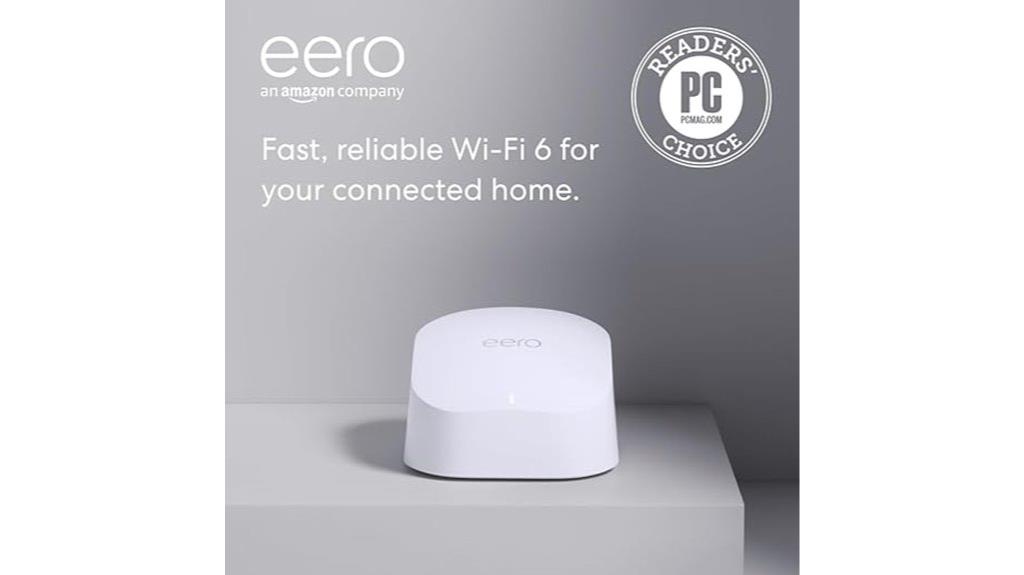
The Amazon eero 6 Mesh Wi-Fi Router stands out as an ideal choice for households seeking reliable, whole-home coverage with minimal setup effort. It covers up to 1,500 sq. ft. and supports internet plans up to 900 Mbps, thanks to Wi-Fi 6 technology that delivers faster speeds for streaming, gaming, and video calls. Supporting over 75 devices at once, it uses TrueMesh tech to reduce dead spots and buffering, ensuring consistent performance. Setting it up takes minutes via the eero app, which also allows easy remote management. Plus, its built-in Zigbee hub simplifies smart home integration, making it a versatile, future-proof router for modern homes.
Best For: households seeking reliable, whole-home Wi-Fi coverage with easy setup and smart home integration.
Pros:
- Supports whole-home coverage up to 1,500 sq. ft. and internet plans up to 900 Mbps
- Easy to set up in minutes via the eero app with remote management capabilities
- Built-in Zigbee hub simplifies smart home device connectivity and automation
Cons:
- Limited to 1,500 sq. ft. coverage per unit, requiring additional units for larger homes
- May be less suitable for ultra-high-speed internet plans exceeding 900 Mbps
- Some advanced network customization options are limited compared to higher-end routers
Amazon eero 6+ Mesh WiFi Router
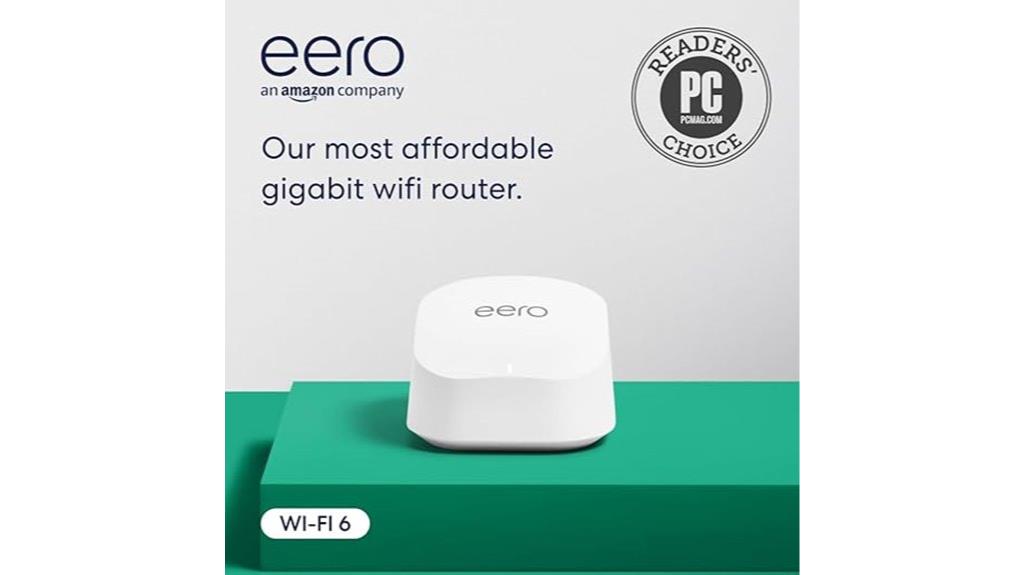
The Amazon eero 6+ Mesh WiFi Router stands out as an ideal choice for families and smart-home users who need reliable high-speed internet coverage across a large area. It supports gigabit speeds up to 1 Gbps and covers up to 1,500 sq. ft., making it suitable for whole-family use. With Wi-Fi 6 and a 160 MHz radio channel, it delivers faster, more reliable connections. Its TrueMesh technology minimizes dead spots, and the built-in Zigbee and Thread hubs streamline smart device integration. Easy to set up via the eero app, it’s expandable and offers remote management, making it a versatile, cost-effective solution for modern connectivity needs.
Best For: families and smart home users seeking reliable high-speed WiFi coverage across a large area with easy setup and smart device integration.
Pros:
- Supports gigabit speeds up to 1 Gbps for fast internet performance
- Covers up to 1,500 sq. ft. and connects over 75 devices simultaneously
- Built-in Zigbee and Thread hubs simplify smart device management
Cons:
- May require a subscription for advanced security features and network management options
- Requires the eero app for setup and management, which may be less familiar to some users
- Limited to Wi-Fi 6, so not compatible with older Wi-Fi standards without upgrade
TP-Link Deco X55 AX3000 Mesh WiFi 6 System (3-Pack)
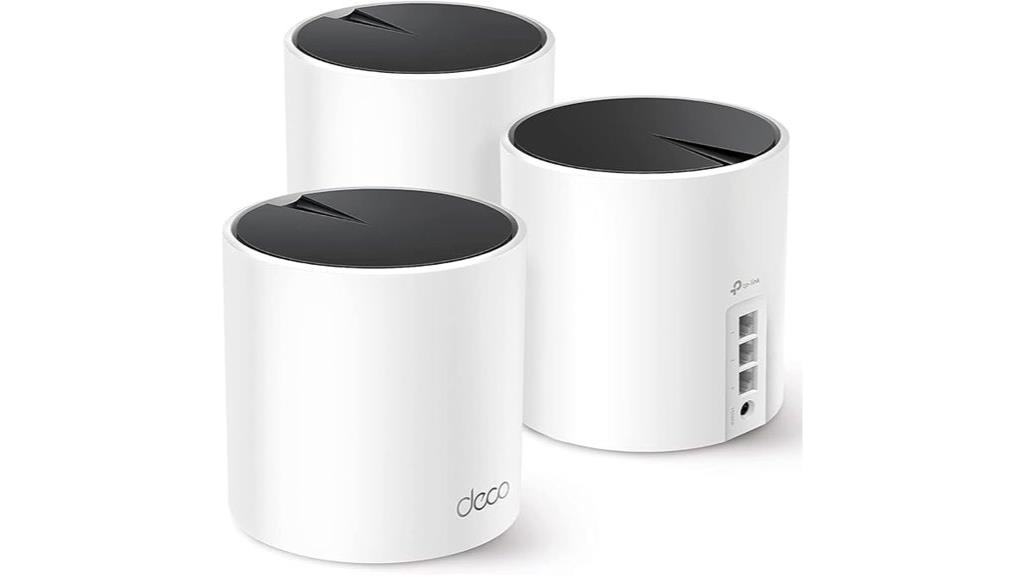
For large households or those with many smart devices, the TP-Link Deco X55 AX3000 Mesh WiFi 6 System (3-Pack) provides seamless coverage and dependable connections. It uses Wi-Fi 6 mesh technology to eliminate dead zones and support up to 6,500 square feet. With speeds up to 2,402 Mbps on the 5 GHz band and 574 Mbps on the 2.4 GHz band, it guarantees fast, reliable internet for all your devices. Connecting up to 150 devices simultaneously, it’s perfect for busy homes. The system features flexible setup options, including Ethernet backhaul, and is easy to manage via the Deco app, making network management simple and secure.
Best For: households with large spaces and multiple smart devices seeking seamless, high-speed Wi-Fi coverage and reliable connections.
Pros:
- Covers up to 6,500 sq ft with whole-home Wi-Fi, eliminating dead zones.
- Supports up to 150 devices simultaneously, ideal for busy households.
- Easy to set up and manage via the Deco app with advanced security features.
Cons:
- Requires multiple units for optimal coverage, which may be more costly.
- Wired Ethernet backhaul setup might be complex for some users.
- May be overkill for small households with minimal devices.
ASUS RT-AX1800S Dual Band WiFi 6 Router

If you’re seeking a reliable WiFi 6 router that balances speed, security, and ease of use, the ASUS RT-AX1800S is an excellent choice. This dual-band router supports MU-MIMO, OFDMA, and 1024-QAM, ensuring fast, efficient connections across multiple devices. It has four external antennas, a dual-core processor, and five Gigabit ports for wired and wireless connectivity. Its features include AiMesh compatibility, parental controls, built-in VPN, and Trend Micro-powered security, making it suitable for gaming, streaming, and smart home devices. Despite some UI quirks, users praise its stability, coverage, and security, making it a solid pick for modern networks.
Best For: those seeking a secure, reliable WiFi 6 router with strong coverage, fast speeds, and user-friendly features for gaming, streaming, and smart home devices.
Pros:
- Supports advanced WiFi 6 features like MU-MIMO, OFDMA, and 1024-QAM for efficient multi-device connections
- Equipped with AiProtection security powered by Trend Micro, providing robust network protection
- Easy to set up with a comprehensive app for device monitoring, bandwidth management, and advanced settings
Cons:
- Some users report UI and user experience issues, such as needing reboots for configuration changes
- Slightly outdated interface design may affect ease of navigation and customization
- Initial setup can be challenging for some, especially via LAN connections
GL.iNet GL-MT6000 (Flint 2) WiFi 6 Gaming Router
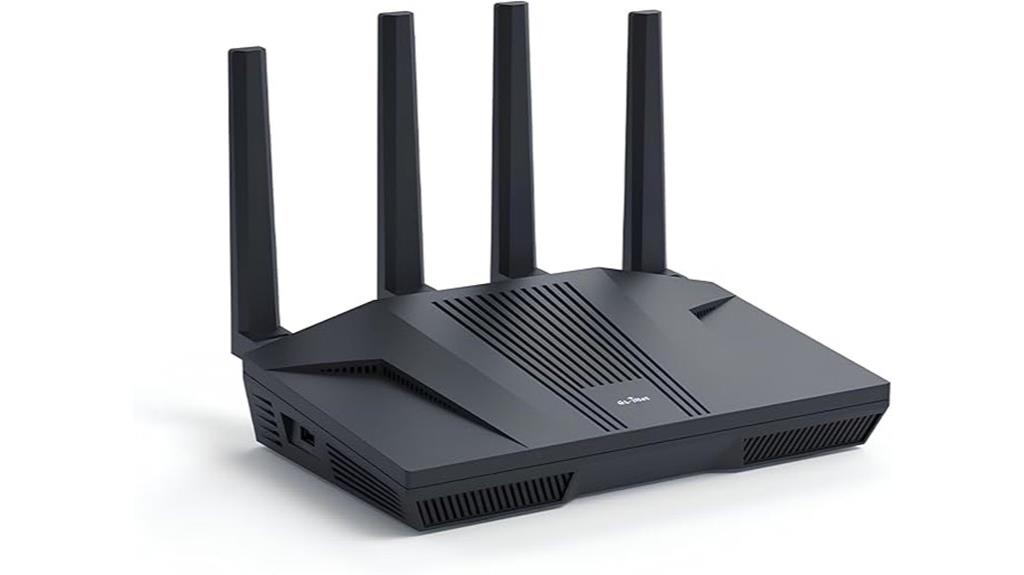
Gamers and busy households will appreciate the GL.iNet GL-MT6000 (Flint 2) WiFi 6 Gaming Router’s high-speed performance and reliable connectivity. It offers speeds up to 6 Gbps with WiFi 6, ensuring smooth 4K streaming, gaming, and video calls. The router features 8-stream Wi-Fi 6 for stable multiplayer gaming and supports over 100 devices simultaneously. Its dual 2.5G Ethernet ports make connecting fiber optic modems straightforward. Compact yet powerful, it’s easy to set up via web or tutorial. With security features like AdGuard Home and VPN support, it provides a safe, fast, and seamless online experience for both gaming and everyday use.
Best For: gamers and busy households seeking high-speed, reliable WiFi 6 connectivity for gaming, streaming, and multiple device use.
Pros:
- Supports speeds up to 6 Gbps with WiFi 6 for smooth gaming and streaming
- Equipped with 8-stream Wi-Fi 6 for stable multiplayer gaming experiences
- Supports over 100 devices simultaneously, ideal for busy households or small offices
Cons:
- Firmware updates are recommended during setup, which may be an extra step for some users
- Actual VPN speeds depend on external factors like ISP and network conditions
- Limited to two 2.5G Ethernet ports, which may not suffice for very large networking setups
NETGEAR Nighthawk WiFi 6 Router (RAX36)
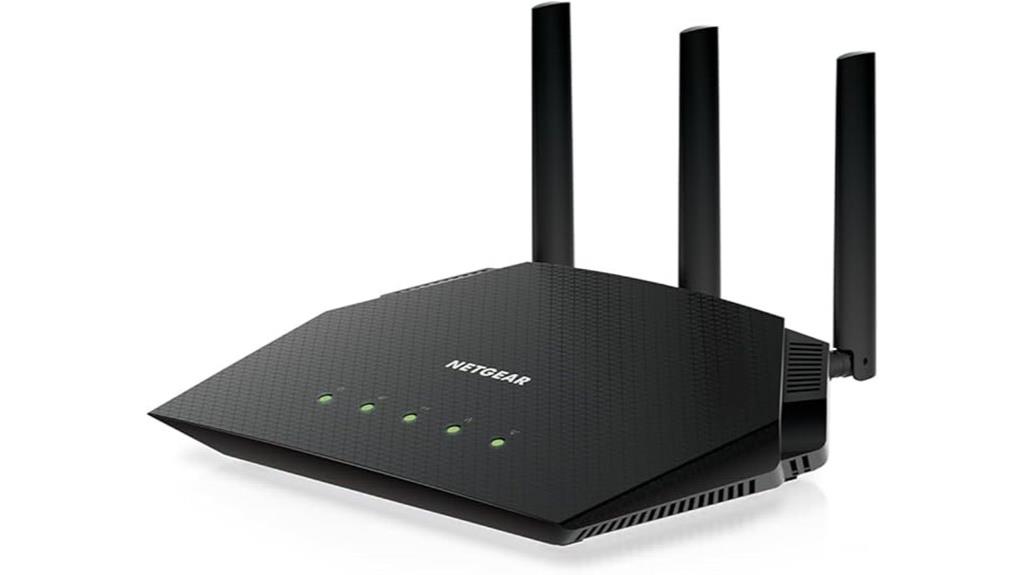
The NETGEAR Nighthawk WiFi 6 Router (RAX36) stands out as an excellent choice for households with multiple devices, thanks to its ability to support up to 25 connections at once. It delivers AX3000 speeds up to 3Gbps, ensuring smooth streaming, online gaming, and video calls. Covering up to 2,000 sq. ft., it’s perfect for larger homes. Setup is straightforward via the Nighthawk App, and it easily replaces your existing cable modem. With four Ethernet ports, built-in security like NETGEAR Armor, a USB 3.0 port, and a built-in VPN, it combines speed, security, and convenience in one powerful package.
Best For: households with multiple devices seeking high-speed, reliable WiFi coverage and robust security features.
Pros:
- Supports up to 25 devices simultaneously for seamless connectivity
- Delivers AX3000 speeds up to 3Gbps for smooth streaming and gaming
- Easy setup and management via the Nighthawk App, replacing existing modems effortlessly
Cons:
- Designed primarily for use in the US only, limiting international compatibility
- Lacks built-in WiFi extenders or mesh capabilities for larger or multi-story homes
- May be overkill for small households or users with basic internet needs
Tenda AX1500 WiFi 6 Router
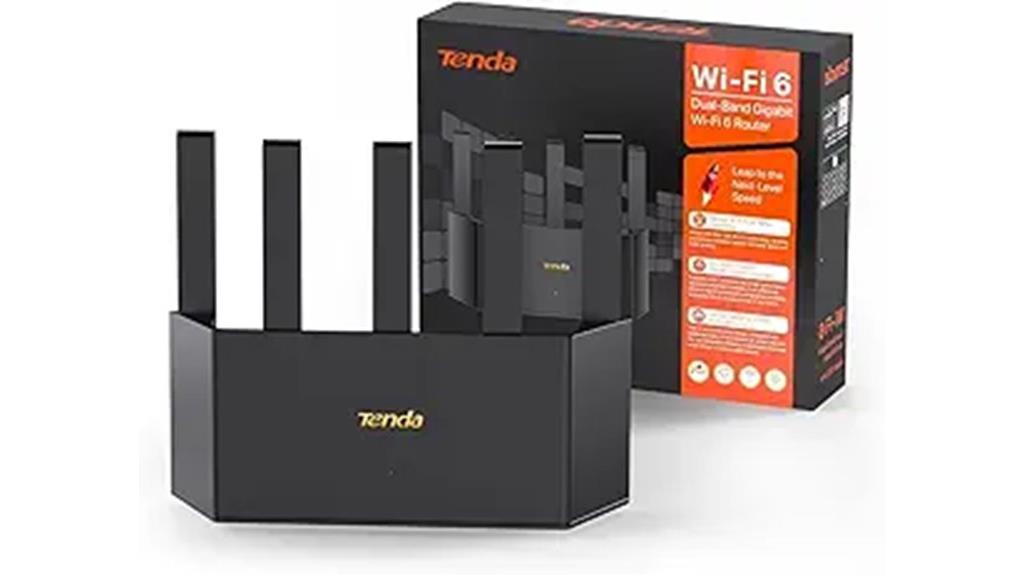
The Tenda AX1500 WiFi 6 Router stands out as an excellent choice for households seeking reliable, high-speed internet coverage without breaking the bank. It delivers dual-band gigabit Wi-Fi with speeds up to 1.5 Gbps—perfect for gaming, streaming, and downloads. Its vertical design improves cooling and network stability, while four gigabit Ethernet ports support wired devices. The router’s four external high-gain antennas and signal enhancement modules boost coverage, even in hard-to-reach corners. Easy to set up via app or web interface, it also supports Tenda’s WiFi+ mesh technology for seamless whole-home coverage. Plus, WPA3 security keeps your network protected.
Best For: households seeking an affordable, reliable Wi-Fi 6 router with broad coverage, easy setup, and strong security features.
Pros:
- Fast dual-band Wi-Fi speeds up to 1.5 Gbps, ideal for streaming and gaming
- Easy setup via app or web interface, suitable for users with limited technical knowledge
- Enhanced coverage with external high-gain antennas and signal modules, even in hard-to-reach areas
Cons:
- Some users experience slower speeds on one band or compatibility issues with certain providers like NBN
- Occasional difficulty during installation for non-technical users
- Slightly higher price point compared to basic models, though offering advanced features
NETGEAR Nighthawk WiFi 7 Router (RS90)
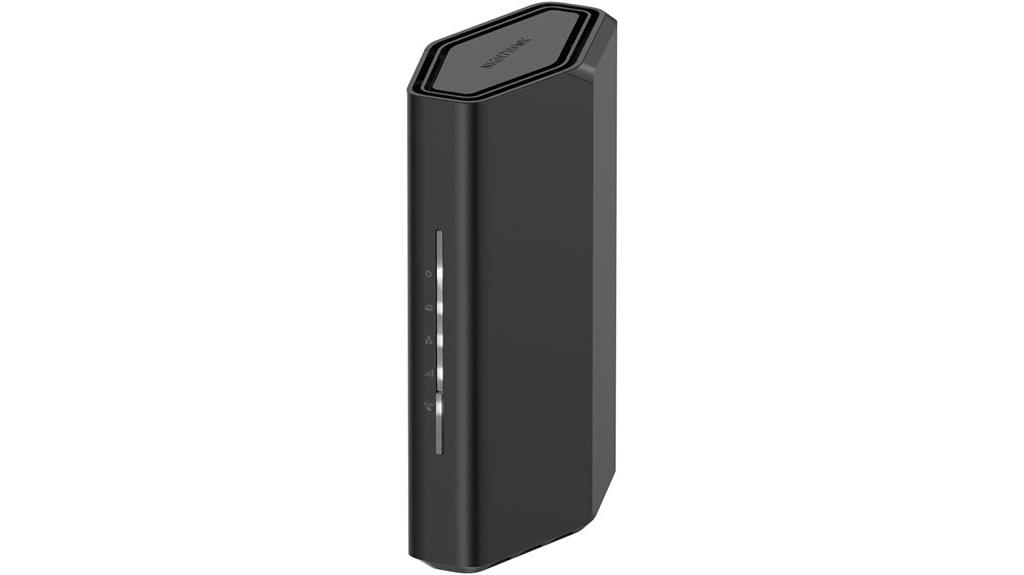
If you’re looking for a high-performance router that can handle multiple devices with ease, the NETGEAR Nighthawk WiFi 7 Router (RS90) is an excellent choice. It offers WiFi 7 speeds up to 3.6 Gbps, making it perfect for gaming, streaming, and video calls. The sleek design covers up to 2,000 square feet and supports around 50 devices simultaneously. Equipped with a 2.5 Gig internet port, it’s compatible with any ISP, though you’ll need a separate modem for your connection. Plus, it includes robust security features like NETGEAR Armor and expert setup support, ensuring fast, secure, and reliable connectivity throughout your home.
Best For: households needing fast, reliable WiFi coverage for multiple devices, including gaming, streaming, and video conferencing.
Pros:
- WiFi 7 speeds up to 3.6 Gbps for high-performance connectivity
- Supports up to 50 devices over a coverage area of 2,000 sq. ft.
- Includes a 2.5 Gig internet port compatible with any ISP and enhanced security features like NETGEAR Armor
Cons:
- Requires a separate modem for internet service since it is a WiFi-only device
- No built-in coax input, limiting compatibility with certain cable services
- May be more expensive compared to older WiFi models or basic routers
Factors to Consider When Choosing Wi‑Fi 6 Routers
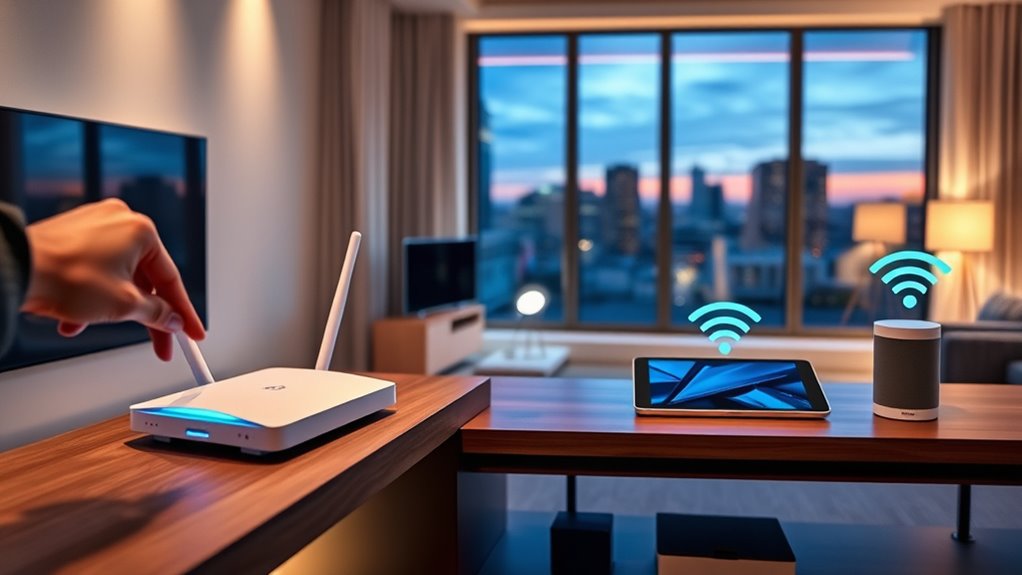
When choosing a Wi-Fi 6 router, I consider factors like speed and bandwidth to guarantee smooth streaming and gaming. Coverage area is also key, so I look for a router that can handle my home’s size without dead spots. Additionally, I check for device compatibility, security features, and how easy it is to set up to make sure it meets my needs.
Speed and Bandwidth
Choosing a Wi-Fi 6 router means paying close attention to speed and bandwidth capabilities, as these directly impact your network’s performance. Wi-Fi 6 routers deliver higher maximum speeds, often over 1.8 Gbps, supporting faster internet plans and multiple devices simultaneously. They use OFDMA technology to split channels into smaller sub-channels, boosting overall capacity and reducing latency. MU-MIMO support enables routers to communicate with several devices at once, improving data throughput and minimizing wait times. The combination of 2.4 GHz and 5 GHz bands allows flexible bandwidth distribution for different devices and activities. Additionally, support for channel widths up to 160 MHz considerably enhances data transfer rates for compatible devices. Prioritizing these speed and bandwidth features guarantees a faster, smoother online experience across your network.
Coverage Area
The coverage area of a Wi-Fi 6 router depends largely on its antenna design, power output, and beamforming technology, which work together to direct signals toward connected devices. Routers with multiple high-gain external antennas and advanced beamforming can better focus signals, increasing coverage. The physical placement of the router also plays a pivotal role; positioning it centrally in your home or office maximizes signal reach. Obstacles like walls, furniture, and appliances can weaken signals and create dead zones, so choosing a router with higher power and better propagation features helps mitigate these issues. For larger spaces or multi-story buildings, mesh Wi-Fi systems or routers with multiple units can extend coverage seamlessly, ensuring consistent connectivity everywhere. Proper setup and hardware choice are key to maximum coverage.
Device Compatibility
Ensuring your Wi-Fi 6 router works seamlessly with your existing devices requires careful attention to compatibility features. First, make sure the router supports the latest Wi-Fi 6 (802.11ax) standards to ensure it’s compatible with all Wi-Fi 6-enabled devices. Check if it works with your internet service provider and supports your connection type, whether fiber, cable, DSL, or satellite. Confirm that security protocols like WPA3 are compatible with your devices to keep your network secure. It’s also wise to verify backward compatibility with Wi-Fi 5 (802.11ac) and earlier standards, so older devices don’t lose connectivity. Lastly, consider your device ecosystem, such as smart home hubs or mesh systems, to guarantee smooth integration with your existing network hardware.
Security Features
Security features are a critical consideration when selecting a Wi-Fi 6 router, as they safeguard your network against growing cyber threats. Many routers now include WPA3, which offers stronger encryption and better protection against password guessing attacks. Built-in security services like TP-Link HomeShield or NETGEAR Armor provide real-time threat detection and malware protection, adding an extra layer of safety. Firmware updates are essential; they patch vulnerabilities and keep your defenses current against emerging threats. Parental controls and guest networks help restrict unauthorized access and protect sensitive data. Industry standards for Wi-Fi 6 emphasize robust encryption, automatic updates, and integrated threat management to ensure safe, reliable wireless communication. Choosing a router with these features helps keep your network secure and your data protected.
Setup Process
Choosing a Wi-Fi 6 router with an easy setup process can save you time and frustration. I look for models with straightforward installation, often guided by mobile apps or web interfaces that walk me through each step. Routers with clear instructions, visual guides, or setup wizards make the process smoother. Compatibility with my existing modem and network setup also speeds things up, especially if auto-detection features are included. I appreciate routers that support quick firmware updates during setup, ensuring security and superior performance from the start. Additionally, remote management or cloud-based setup options are helpful for future adjustments or troubleshooting without hassle. Overall, a simple, guided setup helps me get my network up and running quickly, minimizing headaches from the start.
Price and Value
When selecting a Wi-Fi 6 router, considering both price and value is essential to making a smart investment. Prices range from about $80 for basic models to over $300 for premium ones, reflecting features and performance. It’s important to look beyond the initial cost and think about long-term benefits like faster speeds, more device capacity, and compatibility with future Wi-Fi standards. Higher-priced routers often include advanced security, better coverage, and extra ports, which can be worth the investment for busy homes or small offices. Budget routers may suffice for small households with fewer devices but might lack features like multi-gig ports or extensive mesh support. Balancing cost and features helps ensure you pick a Wi-Fi 6 router that offers the best value for your specific needs.
Future-Proofing
To guarantee your Wi-Fi 6 router remains useful for years to come, it’s important to contemplate features that support future technologies. Look for models with support for the latest standards like WPA3, OFDMA, and MU-MIMO, ensuring compatibility with upcoming devices. Choosing a router with tri-band or WiFi 6E capabilities helps handle growing data demands and new wireless frequencies, extending its relevance. Robust security features, such as automatic firmware updates and integrated cybersecurity, are essential to protect against evolving threats. Additionally, select a router that supports seamless mesh networking and software upgrades, so your network can adapt to changing needs. Considering compatibility with future standards like WiFi 7 guarantees your setup will stay scalable and ready for next-gen wireless devices.
Frequently Asked Questions
How Does Wi-Fi 6 Improve Device Battery Life?
Wi-Fi 6 improves device battery life through a feature called Target Wake Time (TWT). TWT schedules data transmissions, allowing devices to sleep longer between communications, which conserves energy. I’ve noticed my devices last much longer between charges since upgrading to Wi-Fi 6 routers. It’s like giving my gadgets a break, reducing unnecessary power drain, and making my overall connectivity experience more efficient and reliable.
Can Wi-Fi 6 Routers Prioritize Bandwidth for Specific Devices?
Think of Wi-Fi 6 routers as the modern-day equivalent of a traffic cop. Yes, they can definitely prioritize bandwidth for specific devices. I’ve seen this in action, where my smart home devices get the bandwidth they need without slowing down my streaming. This feature, called Quality of Service (QoS), guarantees your most important devices get priority, making your entire network smoother and more responsive.
Are Wi-Fi 6 Routers Compatible With Older Wi-Fi Standards?
Yes, Wi-Fi 6 routers are compatible with older Wi-Fi standards like 802.11a/b/g/n/ac. I’ve found they seamlessly connect to various devices, whether they’re new or legacy ones. This backward compatibility guarantees you don’t have to replace all your devices at once. Plus, your existing equipment will still work, but to enjoy Wi-Fi 6’s full benefits, I recommend upgrading your devices gradually.
What Security Features Are Essential in Wi-Fi 6 Routers?
Security features in Wi-Fi 6 routers are absolutely essential—they’re like a fortress protecting your digital life. I always look for WPA3 encryption, which is the latest and most secure standard, along with automatic firmware updates that patch vulnerabilities instantly. Features like VPN support and parental controls add extra layers of safety, ensuring my network stays private and my family’s online experience remains secure. Protecting your data has never been more important!
How Does Mesh Networking Enhance Wi-Fi 6 Coverage?
Mesh networking boosts Wi-Fi 6 coverage by linking multiple devices to create a seamless network across your home. I’ve experienced this firsthand, noticing fewer dead zones and faster speeds in every corner. It’s especially useful for larger spaces or homes with thick walls. Instead of a single router struggling to reach every room, mesh systems distribute the signal evenly, ensuring reliable, high-speed connectivity wherever you are.
Conclusion
No matter which Wi-Fi 6 router you pick, it’s clear that staying ahead of the curve means investing in smarter, faster connectivity. These top options are all solid choices, but remember, it’s not just about the latest tech — it’s about finding the right fit for your needs. Don’t put all your eggs in one basket; choose wisely and enjoy seamless, future-proof internet that keeps you ahead of the game.
